child seat CHEVROLET KODIAK 2007 Owners Manual
[x] Cancel search | Manufacturer: CHEVROLET, Model Year: 2007, Model line: KODIAK, Model: CHEVROLET KODIAK 2007Pages: 430, PDF Size: 6.06 MB
Page 1 of 430
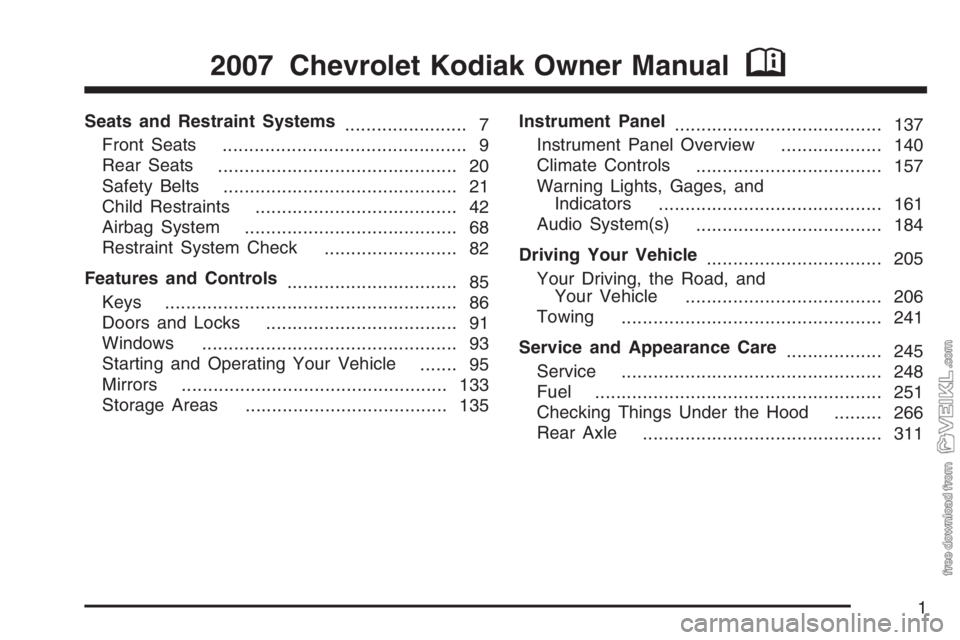
Seats and Restraint Systems
....................... 7
Front Seats
.............................................. 9
Rear Seats
............................................. 20
Safety Belts
............................................ 21
Child Restraints
...................................... 42
Airbag System
........................................ 68
Restraint System Check
......................... 82
Features and Controls
................................ 85
Keys
....................................................... 86
Doors and Locks
.................................... 91
Windows
................................................ 93
Starting and Operating Your Vehicle
....... 95
Mirrors
.................................................. 133
Storage Areas
...................................... 135Instrument Panel
....................................... 137
Instrument Panel Overview
................... 140
Climate Controls
................................... 157
Warning Lights, Gages, and
Indicators
.......................................... 161
Audio System(s)
................................... 184
Driving Your Vehicle
................................. 205
Your Driving, the Road, and
Your Vehicle
..................................... 206
Towing
................................................. 241
Service and Appearance Care
.................. 245
Service
................................................. 248
Fuel
...................................................... 251
Checking Things Under the Hood
......... 266
Rear Axle
............................................. 311
2007 Chevrolet Kodiak Owner ManualM
1
Page 7 of 430
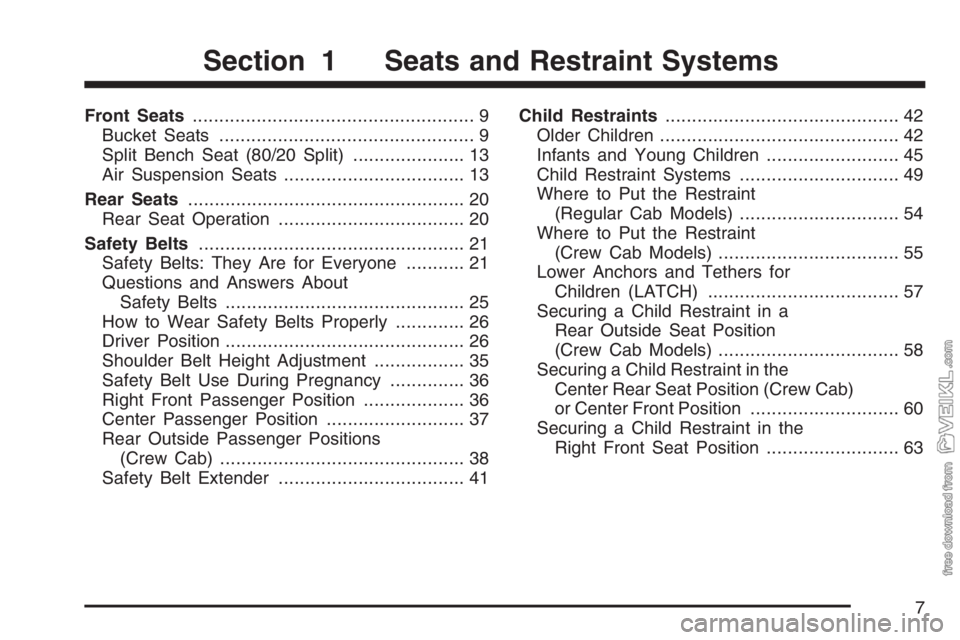
Front Seats..................................................... 9
Bucket Seats................................................ 9
Split Bench Seat (80/20 Split)..................... 13
Air Suspension Seats.................................. 13
Rear Seats.................................................... 20
Rear Seat Operation................................... 20
Safety Belts.................................................. 21
Safety Belts: They Are for Everyone........... 21
Questions and Answers About
Safety Belts............................................. 25
How to Wear Safety Belts Properly............. 26
Driver Position............................................. 26
Shoulder Belt Height Adjustment................. 35
Safety Belt Use During Pregnancy.............. 36
Right Front Passenger Position................... 36
Center Passenger Position.......................... 37
Rear Outside Passenger Positions
(Crew Cab).............................................. 38
Safety Belt Extender................................... 41Child Restraints............................................ 42
Older Children............................................. 42
Infants and Young Children......................... 45
Child Restraint Systems.............................. 49
Where to Put the Restraint
(Regular Cab Models).............................. 54
Where to Put the Restraint
(Crew Cab Models).................................. 55
Lower Anchors and Tethers for
Children (LATCH).................................... 57
Securing a Child Restraint in a
Rear Outside Seat Position
(Crew Cab Models).................................. 58
Securing a Child Restraint in the
Center Rear Seat Position (Crew Cab)
or Center Front Position............................ 60
Securing a Child Restraint in the
Right Front Seat Position......................... 63
Section 1 Seats and Restraint Systems
7
Page 26 of 430
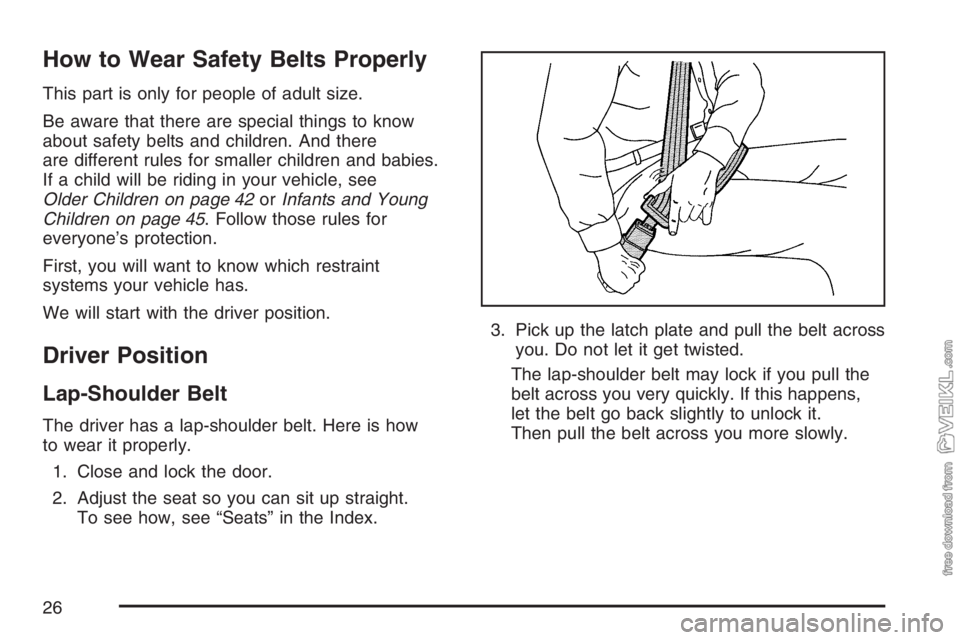
How to Wear Safety Belts Properly
This part is only for people of adult size.
Be aware that there are special things to know
about safety belts and children. And there
are different rules for smaller children and babies.
If a child will be riding in your vehicle, see
Older Children on page 42orInfants and Young
Children on page 45. Follow those rules for
everyone’s protection.
First, you will want to know which restraint
systems your vehicle has.
We will start with the driver position.
Driver Position
Lap-Shoulder Belt
The driver has a lap-shoulder belt. Here is how
to wear it properly.
1. Close and lock the door.
2. Adjust the seat so you can sit up straight.
To see how, see “Seats” in the Index.3. Pick up the latch plate and pull the belt across
you. Do not let it get twisted.
The lap-shoulder belt may lock if you pull the
belt across you very quickly. If this happens,
let the belt go back slightly to unlock it.
Then pull the belt across you more slowly.
26
Page 36 of 430
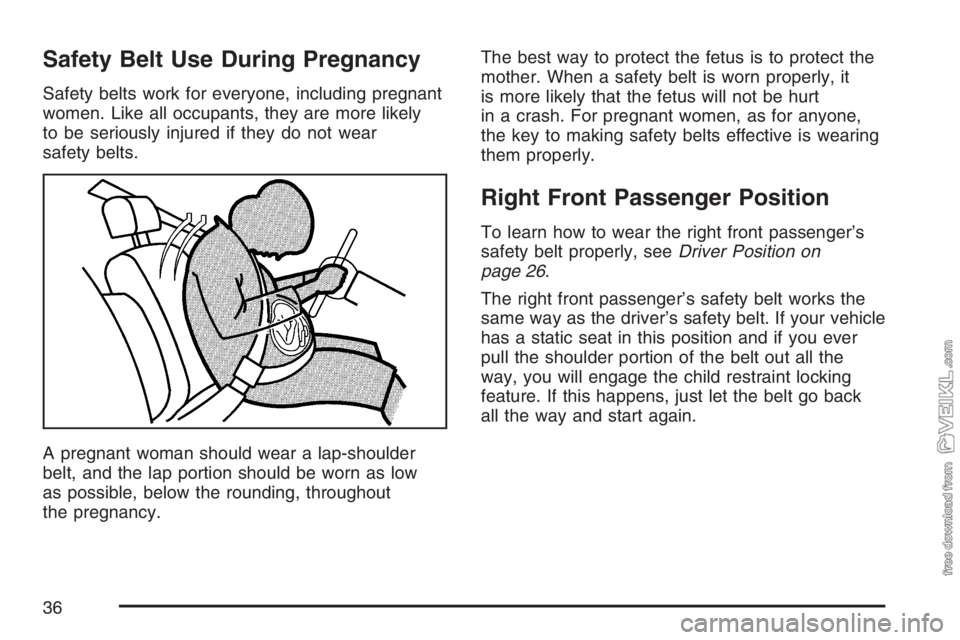
Safety Belt Use During Pregnancy
Safety belts work for everyone, including pregnant
women. Like all occupants, they are more likely
to be seriously injured if they do not wear
safety belts.
A pregnant woman should wear a lap-shoulder
belt, and the lap portion should be worn as low
as possible, below the rounding, throughout
the pregnancy.The best way to protect the fetus is to protect the
mother. When a safety belt is worn properly, it
is more likely that the fetus will not be hurt
in a crash. For pregnant women, as for anyone,
the key to making safety belts effective is wearing
them properly.
Right Front Passenger Position
To learn how to wear the right front passenger’s
safety belt properly, seeDriver Position on
page 26.
The right front passenger’s safety belt works the
same way as the driver’s safety belt. If your vehicle
has a static seat in this position and if you ever
pull the shoulder portion of the belt out all the
way, you will engage the child restraint locking
feature. If this happens, just let the belt go back
all the way and start again.
36
Page 41 of 430
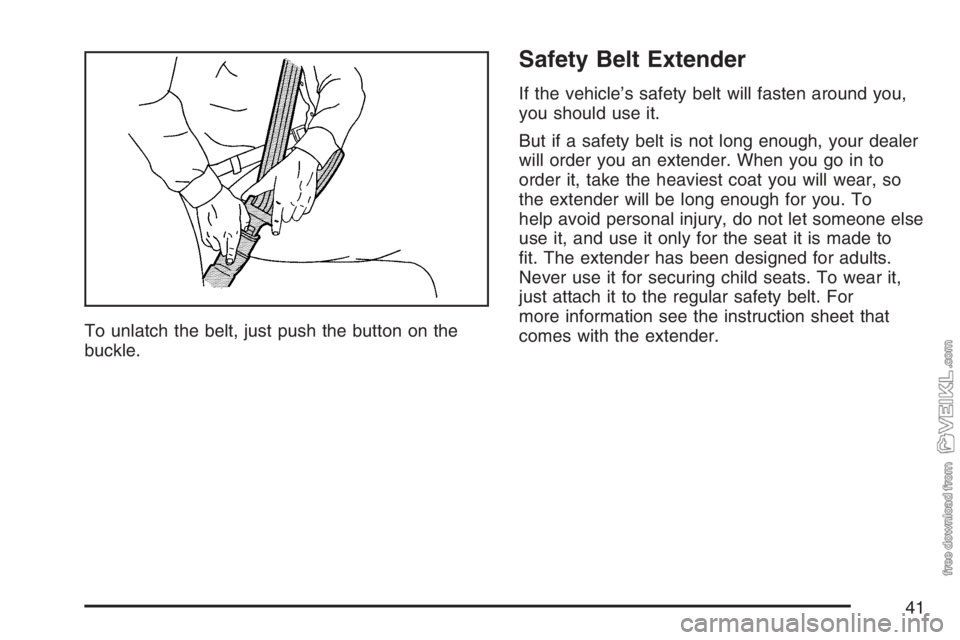
To unlatch the belt, just push the button on the
buckle.
Safety Belt Extender
If the vehicle’s safety belt will fasten around you,
you should use it.
But if a safety belt is not long enough, your dealer
will order you an extender. When you go in to
order it, take the heaviest coat you will wear, so
the extender will be long enough for you. To
help avoid personal injury, do not let someone else
use it, and use it only for the seat it is made to
fit. The extender has been designed for adults.
Never use it for securing child seats. To wear it,
just attach it to the regular safety belt. For
more information see the instruction sheet that
comes with the extender.
41
Page 42 of 430
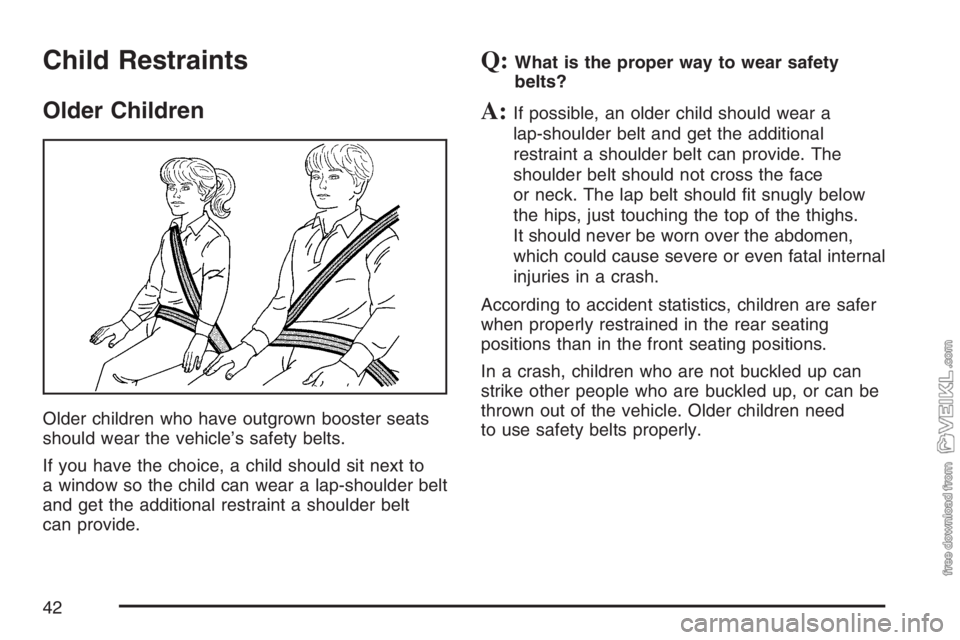
Child Restraints
Older Children
Older children who have outgrown booster seats
should wear the vehicle’s safety belts.
If you have the choice, a child should sit next to
a window so the child can wear a lap-shoulder belt
and get the additional restraint a shoulder belt
can provide.
Q:What is the proper way to wear safety
belts?
A:If possible, an older child should wear a
lap-shoulder belt and get the additional
restraint a shoulder belt can provide. The
shoulder belt should not cross the face
or neck. The lap belt should fit snugly below
the hips, just touching the top of the thighs.
It should never be worn over the abdomen,
which could cause severe or even fatal internal
injuries in a crash.
According to accident statistics, children are safer
when properly restrained in the rear seating
positions than in the front seating positions.
In a crash, children who are not buckled up can
strike other people who are buckled up, or can be
thrown out of the vehicle. Older children need
to use safety belts properly.
42
Page 43 of 430
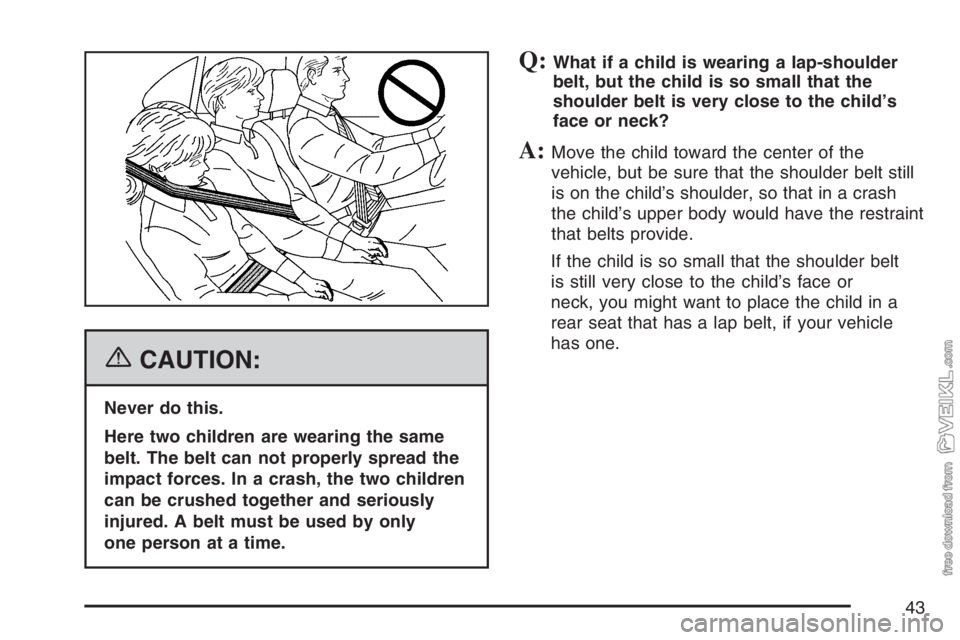
{CAUTION:
Never do this.
Here two children are wearing the same
belt. The belt can not properly spread the
impact forces. In a crash, the two children
can be crushed together and seriously
injured. A belt must be used by only
one person at a time.
Q:What if a child is wearing a lap-shoulder
belt, but the child is so small that the
shoulder belt is very close to the child’s
face or neck?
A:Move the child toward the center of the
vehicle, but be sure that the shoulder belt still
is on the child’s shoulder, so that in a crash
the child’s upper body would have the restraint
that belts provide.
If the child is so small that the shoulder belt
is still very close to the child’s face or
neck, you might want to place the child in a
rear seat that has a lap belt, if your vehicle
has one.
43
Page 44 of 430
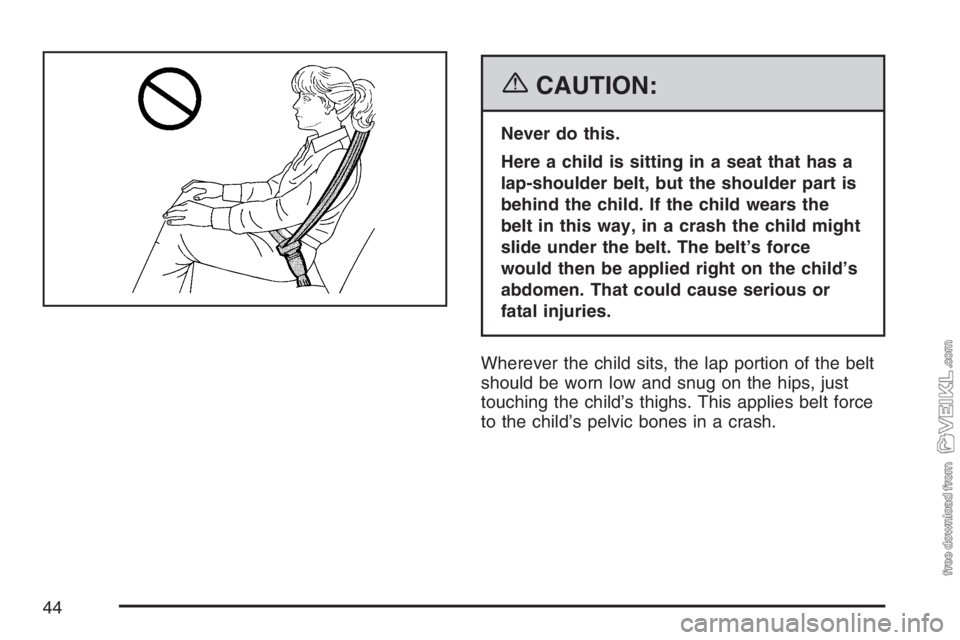
{CAUTION:
Never do this.
Here a child is sitting in a seat that has a
lap-shoulder belt, but the shoulder part is
behind the child. If the child wears the
belt in this way, in a crash the child might
slide under the belt. The belt’s force
would then be applied right on the child’s
abdomen. That could cause serious or
fatal injuries.
Wherever the child sits, the lap portion of the belt
should be worn low and snug on the hips, just
touching the child’s thighs. This applies belt force
to the child’s pelvic bones in a crash.
44
Page 48 of 430
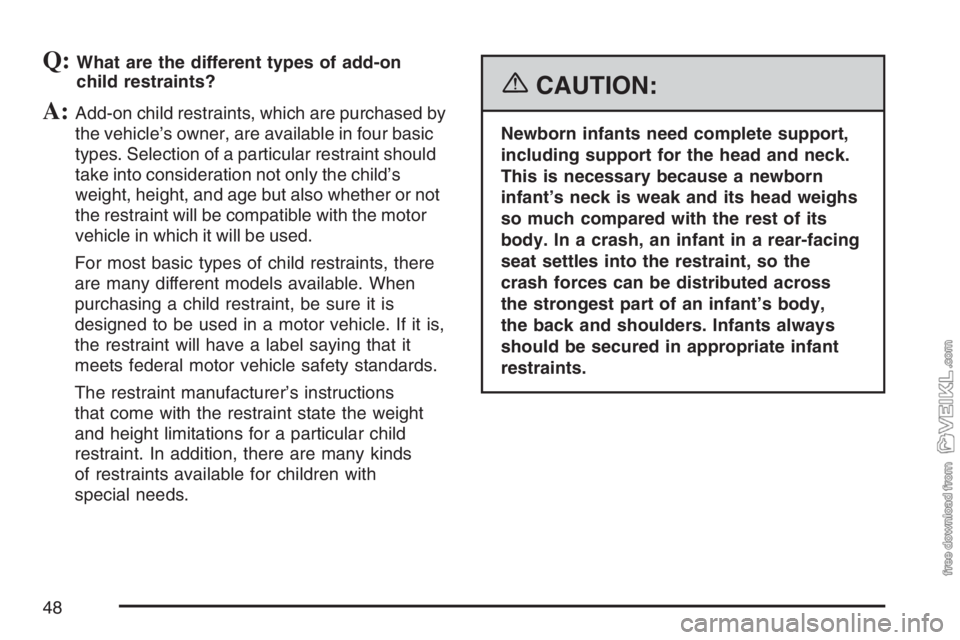
Q:What are the different types of add-on
child restraints?
A:Add-on child restraints, which are purchased by
the vehicle’s owner, are available in four basic
types. Selection of a particular restraint should
take into consideration not only the child’s
weight, height, and age but also whether or not
the restraint will be compatible with the motor
vehicle in which it will be used.
For most basic types of child restraints, there
are many different models available. When
purchasing a child restraint, be sure it is
designed to be used in a motor vehicle. If it is,
the restraint will have a label saying that it
meets federal motor vehicle safety standards.
The restraint manufacturer’s instructions
that come with the restraint state the weight
and height limitations for a particular child
restraint. In addition, there are many kinds
of restraints available for children with
special needs.
{CAUTION:
Newborn infants need complete support,
including support for the head and neck.
This is necessary because a newborn
infant’s neck is weak and its head weighs
so much compared with the rest of its
body. In a crash, an infant in a rear-facing
seat settles into the restraint, so the
crash forces can be distributed across
the strongest part of an infant’s body,
the back and shoulders. Infants always
should be secured in appropriate infant
restraints.
48
Page 49 of 430
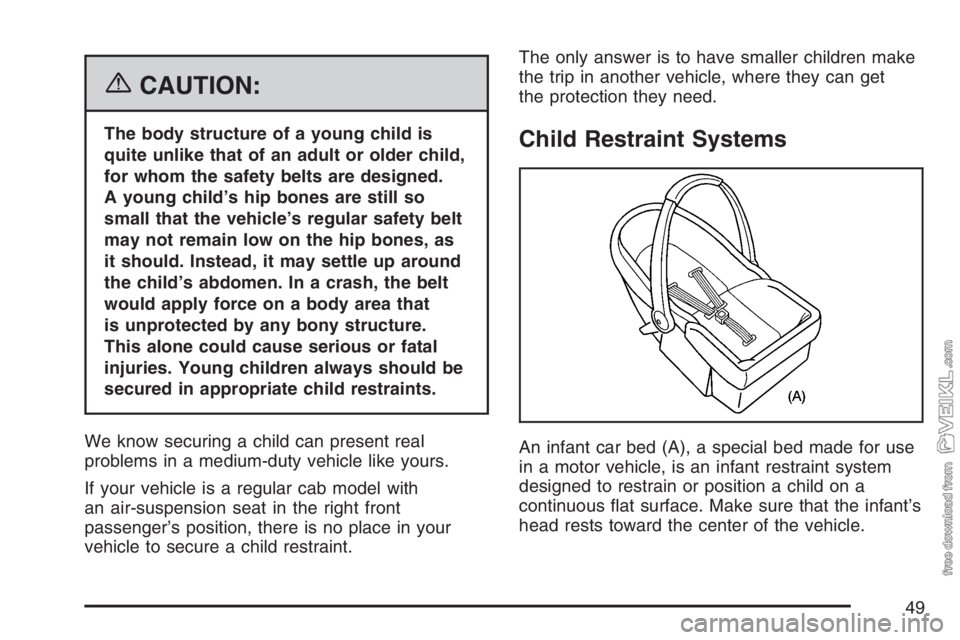
{CAUTION:
The body structure of a young child is
quite unlike that of an adult or older child,
for whom the safety belts are designed.
A young child’s hip bones are still so
small that the vehicle’s regular safety belt
may not remain low on the hip bones, as
it should. Instead, it may settle up around
the child’s abdomen. In a crash, the belt
would apply force on a body area that
is unprotected by any bony structure.
This alone could cause serious or fatal
injuries. Young children always should be
secured in appropriate child restraints.
We know securing a child can present real
problems in a medium-duty vehicle like yours.
If your vehicle is a regular cab model with
an air-suspension seat in the right front
passenger’s position, there is no place in your
vehicle to secure a child restraint.The only answer is to have smaller children make
the trip in another vehicle, where they can get
the protection they need.Child Restraint Systems
An infant car bed (A), a special bed made for use
in a motor vehicle, is an infant restraint system
designed to restrain or position a child on a
continuous flat surface. Make sure that the infant’s
head rests toward the center of the vehicle.
49